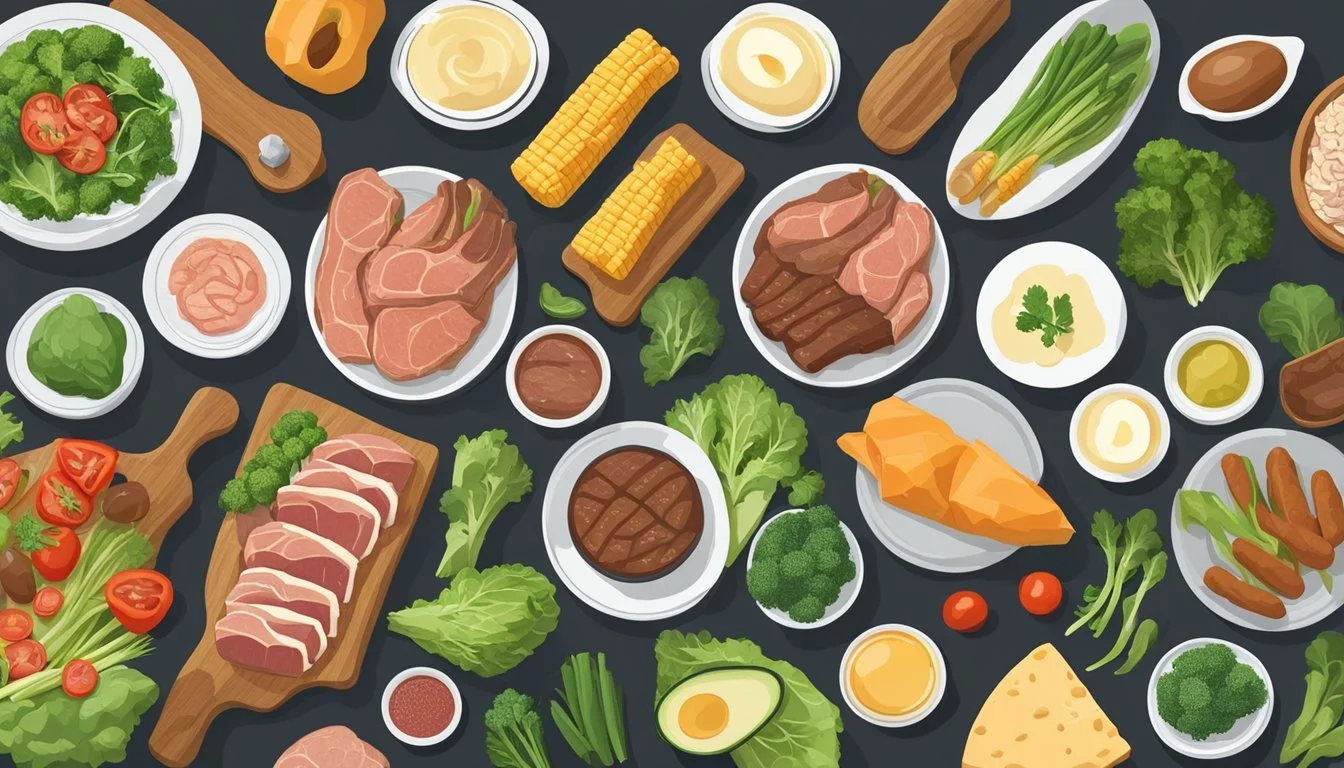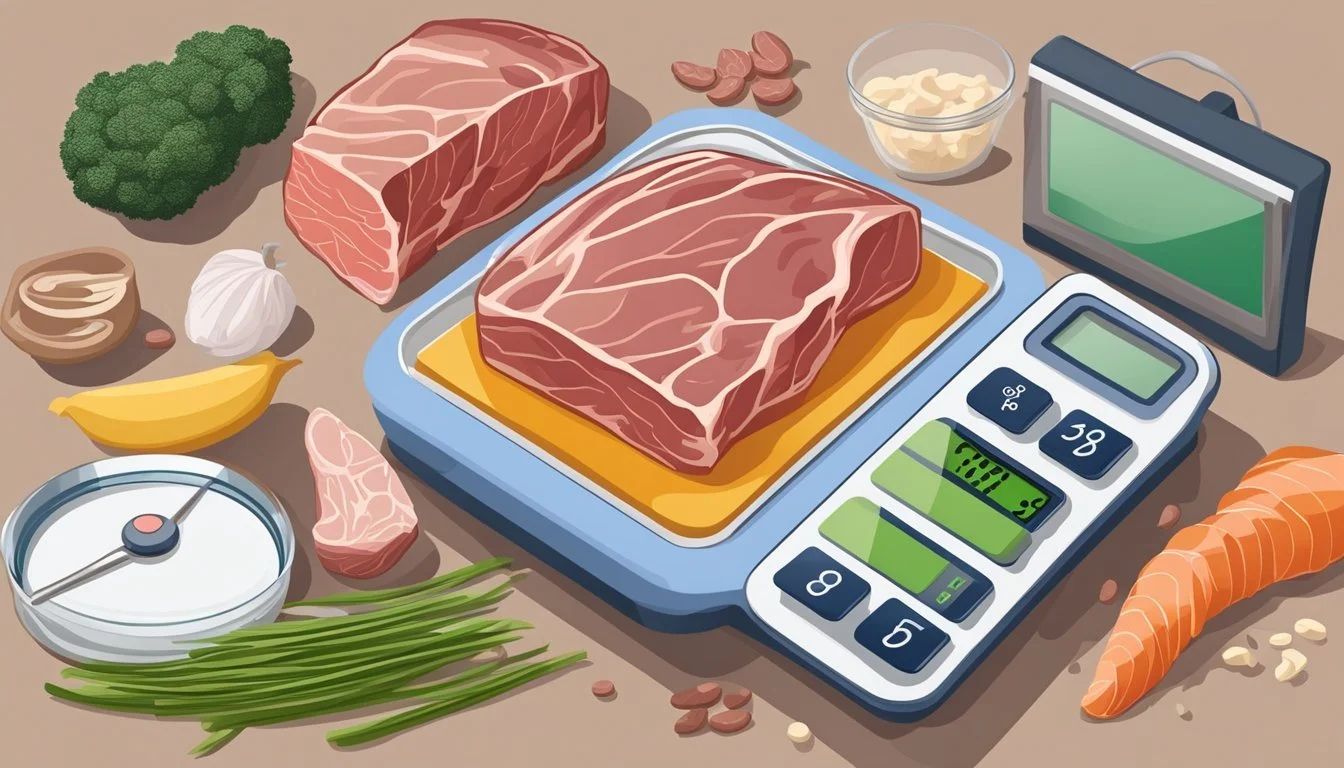Keto Diet: Eating Too Much Protein
Balancing Your Macros for Success
The ketogenic, or keto, diet is a low-carb, high-fat diet that has gained popularity for its potential to promote weight loss and improve certain health conditions. One of its core principles is to induce a state of ketosis where the body, deprived of carbohydrates, starts to burn fat as its primary source of fuel. A typical keto diet emphasizes a high intake of fats, moderate protein, and very low carbohydrates. The recommended protein intake on a ketogenic diet is often subject to discussion, as it is pivotal in maintaining muscle mass without undermining the ketosis process.
Maintaining the right amount of protein intake is crucial while following the keto diet. Protein should be consumed in moderation as the body can convert excess protein into glucose through a process called gluconeogenesis, potentially impacting the ketogenic state. While a moderate protein intake is important for muscle repair and satiety, it is essential to balance this need with the diet's requirements to stay in ketosis. Protein needs can vary from person to person based on factors such as activity level, age, muscle mass, and overall health.
The keto diet operates on calculated macronutrient ratios, generally consisting of approximately 20-25% intake from protein, 65-80% from fats, and the remaining 3-10% from carbohydrates. Calculating individual calorie and macronutrient targets can help individuals adhere to these ratios, ensuring that they consume enough protein to support their bodily functions while remaining in ketosis to achieve their dietary goals.
Understanding the Keto Diet
The ketogenic diet prioritizes fat as the primary energy source, dramatically reducing carbohydrates. It meticulously balances macronutrient intake to maintain the metabolic state of ketosis.
Principles of Ketosis
Ketosis is a metabolic state in which the body, due to a significant reduction in carbohydrate intake, begins to burn fat for energy instead of the usual glucose. This shift results from the liver converting fats into ketones, which serve as an alternate energy source. Entering ketosis typically requires limiting carbohydrate consumption to about 20 to 50 grams per day.
Macronutrient Ratios
The ketogenic diet has specific macronutrient ratios that are key to inducing ketosis:
Proteins: 20-25%
Fats: 65-80%
Carbohydrates: 3-10%
These percentages are flexible and may be adjusted based on individual needs and reactions to the diet.
Roles of Carbs, Fats, and Proteins
Carbohydrates: On a keto diet, they are kept to a minimum to prevent glucose reliance.
Healthy Fats: These are the cornerstone of the diet, with sources including avocados, coconut oil, and nuts.
Proteins: Sufficient intake is crucial yet moderate; too much can interfere with ketosis due to gluconeogenesis, which is when protein is converted into glucose.
Health Benefits of Keto
While the keto diet is often associated with weight loss, it also may offer other health benefits, such as improved insulin sensitivity and potentially a supportive role in managing neurological conditions. However, individual experiences with the ketogenic diet vary, and its long-term effects are still being researched.
Protein's Place in Keto
In a ketogenic diet, protein intake is a balancing act that requires careful consideration to maintain ketosis. Protein serves crucial functions but must be consumed in appropriate quantities to prevent disrupting ketone production.
Functions of Protein
Protein fulfills several key roles in the body:
Muscle mass maintenance: Protein is essential for building and repairing muscle tissue.
Amino acids supply: Provides nine essential amino acids that the body cannot synthesize.
Metabolic functions: Aids in various metabolic processes, including hormone production.
Protein Intake and Ketosis
Protein consumption on a keto-friendly diet should align with maintaining ketone levels in the blood. While protein is vital, one must:
Moderate intake: Ensure a moderate protein intake to avoid gluconeogenesis, where the liver converts protein to glucose, potentially reducing ketone production.
Individualized portions: Tailor protein quantity to one's body demands without overconsumption that could lead to suboptimal ketosis.
Signs of Excessive Protein
Excess protein on a ketogenic diet can lead to certain indicators:
Blood sugar spikes: Elevated blood sugar levels can signal overconsumption of protein, as excess can convert to sugar via gluconeogenesis.
Decrease in ketone levels: Testing may show lower blood ketone concentrations, suggesting that too much dietary protein is undermining ketosis.
Food Sources and Choices
When following a ketogenic diet, choosing the right protein sources is crucial to maintaining ketosis without consuming too many carbohydrates. The diet typically prioritizes high-fat and moderate-protein foods, so it's important to select protein sources that align with these macronutrient ratios.
Animal-Based Protein Foods
Animal-based protein foods are a staple in the ketogenic diet due to their low carbohydrate content and high protein and fat levels. Here's a concise list of keto-friendly animal proteins:
Beef: A versatile source of protein, beef is keto-friendly, especially in cuts like steak that are higher in fat.
Pork: Including cuts such as pork chops and bacon, pork can be a part of the keto diet but should be consumed in moderation due to its saturated fat content.
Poultry: Chicken and turkey are excellent protein sources; opting for darker meats can increase fat intake.
Eggs: Highly nutritious and rich in protein, eggs can be incorporated into the diet in many ways.
Butter: While not high in protein, butter is a source of high-quality fat that can accompany animal proteins.
Plant-Based Protein Foods
For those seeking plant-based alternatives or looking to diversify their protein intake, these sources are keto-compliant:
Tofu: A versatile soy-based product, tofu is an appropriate protein source for the ketogenic diet.
Nuts: Almonds, walnuts, and pecans are low in carbohydrates and high in fat, making them ideal for a keto diet. However, portion control is essential as nuts can be calorie-dense.
Seeds: Chia seeds, flaxseeds, and pumpkin seeds are also packed with protein and keto-friendly fats.
It's essential to monitor the carb content of plant-based proteins to stay within the ketogenic macronutrient framework.
Protein-Rich Snacks
Incorporating protein-rich snacks into a ketogenic diet can help maintain satiety between meals. Here are some snack ideas that fit the keto parameters:
Cheese: Full-fat varieties like cheddar, mozzarella, and brie provide a good balance of fat and protein.
Olives: Paired with olive oil, olives can be a flavorful, fat-rich protein snack.
Vegetables: Low-carb options like spinach, cauliflower (how long does cauliflower last?), broccoli, and mushrooms can be paired with high-fat dips to create satisfying snacks.
These snacks can help one maintain energy levels and protein intake throughout the day without excessive carbohydrate consumption.
Protein and Weight Management
In the context of a ketogenic diet, protein plays a crucial role in managing weight by influencing both appetite and body composition.
Protein's Role in Weight Loss
Protein is a key macronutrient for weight loss due to its higher thermic effect and its ability to satiate hunger. Thermic effect refers to the energy expenditure associated with the digestion, absorption, and metabolism of nutrients. Protein has a higher thermic effect than fats or carbohydrates, meaning the body uses more calories to process protein. This can contribute to an increased metabolic rate.
Protein also impacts appetite regulation. By increasing the release of satiety hormones, protein can make an individual feel full longer, thus potentially reducing the overall caloric intake. Research shows that a diet higher in protein can help preserve lean mass during weight loss, which is crucial since lean mass contributes to a higher resting metabolic rate.
Adjusting Protein for Fat Loss
To optimize fat loss on a ketogenic diet, adjusting protein intake is essential. Consuming adequate amounts of protein can prevent loss of muscle mass, which often accompanies weight loss. On the other hand, too much protein can hinder the state of ketosis, where the body burns fat for fuel instead of carbohydrates.
For fat loss, it's recommended to calculate protein needs based on body weight. A general guideline is to consume between 1.2 to 1.7 grams of protein per kilogram of body weight, depending on the individual's activity level and body composition goals. For those aiming to lose body fat while maintaining muscle, staying within this range can support weight loss objectives effectively. It is equally crucial to distribute protein intake evenly throughout the day to maintain muscle protein synthesis.
By managing protein intake, individuals can work towards achieving a reduction in body fat and an improvement in overall body composition, without sacrificing lean mass.
Health Considerations and Risks
When undertaking a ketogenic diet with a high protein intake, individuals must consider the potential health risks including blood sugar fluctuations, kidney strain, and the impact on heart health.
Managing Blood Sugar Levels
Eating a large amount of protein can affect blood sugar levels. In individuals without diabetes, the body typically manages the gluconeogenic response efficiently. However, for those with type 2 diabetes, excessive protein might lead to increased blood sugar levels, as the liver converts excess amino acids to glucose, challenging insulin regulation and potentially interfering with ketosis.
Kidney Function and Protein
High protein intake over an extended period can put stress on the kidneys, especially in individuals with pre-existing kidney conditions. The kidneys are responsible for filtering waste products from digestion, including byproducts of protein metabolism. Increased protein can lead to higher rates of filtration, potentially exacerbating kidney function issues and increasing blood pressure.
Heart Health and Cholesterol
The relationship between a high-fat ketogenic diet, which often incorporates increased protein intake, and heart health is complex. Saturated fats and cholesterol in the diet can influence blood cholesterol levels, an important risk factor for heart disease. However, the impact varies among individuals. While some may experience elevated cholesterol levels, others may see an improvement in their lipid profile. Monitoring blood lipid levels is advisable to mitigate any potential risks related to heart health.
Adjusting Your Keto Diet
When embarking on a ketogenic diet, it's essential to tailor your macronutrient intake to maintain ketosis and achieve your goals. Monitoring and adjusting the diet when necessary ensures the body utilizes fats rather than excess proteins for energy.
Customizing Macronutrient Intake
Individuals following a ketogenic diet should focus on balancing their macronutrient intake—their macros—which primarily consists of fats, proteins, and carbohydrates. To remain in a state of ketosis, where the body burns fat for energy, carbohydrate intake must be kept to a minimum, typically between 20-50 grams per day. Protein should be consumed in moderation; an excessive amount may prompt the body to convert protein into glucose in a process called gluconeogenesis, which can disrupt ketosis.
Adjusting protein and carb intake can be precisely managed by using a macronutrient calculator, a tool designed to specify individual macro ratios based on personal health goals and body composition. These calculated ratios are starting points, and individuals may need to experiment with their macro distribution to find the optimal balance for maintaining ketosis. Ketone meters can be used to monitor ketone levels, providing real-time feedback on the body's state of ketosis.
When to Consult a Doctor
Consulting a doctor is advisable, especially for individuals with pre-existing health conditions or those new to a ketogenic diet. A doctor can offer guidance on appropriate macronutrient ratios and how they fit into one's overall health plan.
Medical professionals can also assist in interpreting results from a ketone meter and advise on dietary adjustments to maintain the desired pH and ketone levels. They can ensure that the ketogenic diet does not negatively impact health and help to prevent any potential nutrient deficiencies. It is important to seek professional advice before making significant dietary changes to ensure they align with one's individual health needs.
Lifestyle and Exercise
In the context of a ketogenic diet, lifestyle and exercise play pivotal roles in achieving optimal body composition and health. Specifically, incorporating resistance training and understanding keto-adaptation for athletes are crucial for those looking to maintain muscle growth and utilize stored fat for energy.
Incorporating Resistance Training
Resistance training is a powerful companion to the ketogenic diet for individuals aiming to promote muscle growth and improve body composition. While following a low carb regimen, resistance exercises encourage the body to preserve and even build muscle mass. This type of training typically includes lifting weights or using resistance bands. It's important to note that muscle tissue is metabolically active and can assist in burning stored fat, contributing to a more toned physique.
Keto-Adaptation for Athletes
Athletes on a ketogenic diet may experience a period of adaptation where their bodies adjust to using fats as the primary fuel source during exercise. This process, known as keto-adaptation, can take several weeks to months. Once adapted, athletes often report sustained energy levels and reduced reliance on dietary carbohydrates. This can be particularly beneficial in endurance sports where long-term energy stability is crucial. Keto-adapted athletes should still ensure they consume adequate protein to support the demands placed on their muscles during training.
By aligning exercise routines with the ketogenic lifestyle, individuals can optimize their physical activities to better support their low-carb, high-fat dietary choices. Resistance training helps in maintaining lean muscle tissue, while keto-adaptation allows athletes to efficiently harness energy from fat reserves.
Special Considerations
When adapting a ketogenic diet to meet individual health requirements, specific conditions and long-term adherence must be factored into the protein intake strategy. These variables can substantially influence the diet's effectiveness and sustainability.
Keto Diet for Specific Conditions
Individuals with conditions such as epilepsy or cancer may require personalized ketogenic diets. For those with epilepsy, the diet can help to reduce seizure frequency due to its effects on neurotransmitter balance and neuronal excitability. Cancer patients may use a ketogenic diet to decrease glucose availability to cancer cells, arguably slowing down tumor growth, as cancer cells predominantly utilize glucose for energy.
Epilepsy: Adjustments in macronutrient ratios can be critical, as too much protein may disrupt ketosis, which is central to managing seizures.
Cancer: Research suggests that a strict ketogenic approach might contribute to cancer therapy, but protein levels should be monitored to avoid impeding therapeutic ketosis.
Long-Term Sustainability
The adoption of a ketogenic diet for extended periods necessitates careful consideration of metabolic and hormonal health benefits.
Metabolism: A high-protein ketogenic diet might influence insulin sensitivity, potentially aiding those with metabolic disorders. However, balance is crucial to maintain the metabolic state of ketosis.
Hormones: Fluctuations in hormone levels can affect body composition and muscle growth, and a ketogenic diet can support hormonal regulation when proteins are consumed at moderate levels.
Muscle Growth: Sufficient protein aids in muscle repair and growth; too little can cause muscle loss, while too much may lead to the keto flu—a collection of symptoms resulting from the body's transition into ketosis.
Health Benefits: The ketogenic diet's potential benefits—ranging from weight loss to improved mental clarity—can be compromised if protein intake is not aligned with individual energy and nutritional demands.
Incorporating these factors into a ketogenic lifestyle can help individuals achieve their health goals while ensuring the diet remains effective and beneficial in the long term.
Supplements and Keto Diet
When adopting a keto diet, one must ensure adequate intake of essential nutrients to support metabolic processes, such as maintaining hormone balances and facilitating ketosis. This often involves incorporating specific supplements to compensate for any dietary deficiencies.
Vitamins and Electrolytes
The body's need for vitamins and electrolytes can change when it shifts from using glycogen to ketones as its primary energy source. They should monitor their intake of sodium, potassium, magnesium, calcium, and vitamins D, B, and C to support hormone function and digestion. Here's a brief look at their importance:
Sodium: Crucial for nerve function and fluid balance.
Potassium: Aids muscle function and helps prevent cramps.
Magnesium: Supports energy production and muscular health.
Calcium: Vital for bone health and muscular function.
Vitamin D: Facilitates calcium absorption and modulates cell growth.
B Vitamins: Essential for energy production.
Vitamin C: Important for immune function and collagen synthesis.
A balanced keto diet, combined with targeted supplementation, can help prevent nutrient deficiencies.
Exogenous Ketones and MCTs
Exogenous ketones and MCTs (Medium-Chain Triglycerides) are popular supplements among keto dieters, providing a direct source of ketones to sustain energy levels and aid in maintaining a state of ketosis.
Exogenous Ketones: These supplements may provide additional ketones, potentially easing the transition into ketosis and alleviating the symptoms of "keto flu."
MCTs: Typically found in coconut oil, MCTs are rapidly absorbed and converted into ketones by the liver. Regular intake might support weight management and energy stability.
These supplements can bolster a ketogenic diet by ensuring a consistent supply of ketones, potentially enhancing the diet's effectiveness for weight loss and metabolic health.
Dealing with Side Effects
When following a ketogenic diet, eating too much protein may lead to side effects such as the keto flu and digestive issues. Knowing how to combat these effects is essential for maintaining both comfort and adherence to the diet.
Combating Keto Flu
The keto flu occurs when transitioning to a ketogenic state, leading to symptoms similar to the flu. It's often related to hypoglycemia, an abrupt drop in blood sugar levels, and a decrease in appetite as the body adjusts to ketosis.
It's important to stay hydrated and replenish electrolytes; sodium, potassium, and magnesium are key. Individuals may consider:
Drinking bone broth or bouillons to replenish sodium levels.
Consuming foods like avocados or spinach that are high in potassium.
Taking a magnesium supplement if dietary intake is insufficient.
Ensuring moderate protein consumption in line with activity levels helps to prevent excess gluconeogenesis, which could otherwise exacerbate keto flu symptoms.
Alleviating Digestive Issues
Protein plays a crucial role in digestion and appetite regulation, but excess protein may lead to constipation or other gastrointestinal discomfort on a keto diet. Addressing these concerns involves a multi-faceted approach:
Fiber intake: Including non-starchy vegetables or keto-friendly fiber supplements can help maintain regular bowel movements.
Hydration: Sufficient water intake is vital, as it can help fiber function properly and ease constipation.
Digestive enzymes: Supplements that contain enzymes like protease can aid protein digestion and reduce discomfort.
Monitoring protein intake to ensure it's within a recommended range for the individual's body mass and activity level is key to preventing these digestive side effects.
Recipe Ideas and Substitutions
Making dietary adjustments to accommodate a high-protein, ketogenic lifestyle can be simplified through strategic recipe substitutions. This section provides practical ideas for high-protein keto meals, vegetable-centric dishes, and dairy alternatives to help maintain ketosis while ensuring nutritional needs are met.
High-Protein Keto Meals
Incorporating high-protein meals into a keto diet often requires choosing recipes that balance both protein and fat intake. Meals such as Snickerdoodle N'Oatmeal, which leverages protein-rich ingredients like seeds and nuts, offer a comforting breakfast option with significant protein content. For lunch or dinner, one could opt for a grass-fed beef stir-fry, using olive oil as a source of unsaturated fats. When selecting meats, preference should be given to grass-fed meat to optimize the intake of healthier fats.
Example: Avocado Egg Bowls
Protein: Eggs, cheese
Fat sources: Avocado (unsaturated fat), butter (saturated fat)
Vegetable-Based Dishes
Keto meals can be abundant in vegetables, providing essential nutrients and fiber. Vegetables like zucchini, cauliflower, and spinach can be used as substitutes for high-carbohydrate ingredients. A zucchini lasagna, for instance, replaces traditional pasta with thinly sliced zucchini, maintaining the flavors of the dish while reducing carbs.
Example: Cauliflower Rice
Vegetable: Cauliflower
Preparation: Grated and sautéed in olive oil
Dairy and Alternative Options
Dairy products are common in keto diets but can be replaced with alternatives for those with sensitivities or preferences. Unsweetened coconut cream can substitute for heavy cream, while almond or cashew-based cheeses can replace traditional dairy cheeses. When utilizing butter, it is beneficial to choose options from grass-fed cows to increase the intake of saturated fats known to be less processed.
Example: Cheese Swaps
Dairy: Regular cheese
Substitutes: Nut-based cheeses (almond, cashew)
Monitoring Progress
When pursuing a ketogenic diet, individuals must closely monitor their progress to ensure they are staying within the boundaries for ketosis. Precise tracking of ketone levels and macronutrient intake is critical to achieving the desired metabolic state.
Measuring Ketone Levels
Ketone levels are indicative of an individual's state of ketosis. Measuring them can be done through various methods, such as blood ketone meters, breath analyzers, or urine strips. Blood ketone meters provide the most accurate readings, and one should aim for a ketone level of over 1.5 mmol/L for optimal ketosis, while levels around 0.5 mmol/L may suggest the need for dietary adjustments.
Tracking Protein and Carb Intake
The balance of macros—proteins, fats, and carbohydrates—is essential for maintaining ketosis. Individuals should monitor their protein intake to prevent excess from potentially disrupting ketosis while adhering to their specific carb limit. Calculating net carbs—total carbs minus fiber—helps in maintaining the typically recommended amount of under 50 grams per day. Daily intake can be logged using apps or food diaries to keep track of both protein grams and net carb consumption.
Conclusion
When adhering to a ketogenic diet, protein consumption is a balancing act. Individuals must be mindful of their protein intake, ensuring it is neither too low nor excessively high. The appropriate protein level supports muscle mass maintenance and aids in post-workout recovery while still facilitating fat burning and promoting metabolic health.
Research suggests that moderate amounts of protein may help individuals maintain ketosis. The typical recommendation is that protein should constitute about 20-25% of daily macronutrient intake, depending on personal health goals and activity levels. It is important to note that overconsumption of protein could potentially lead to gluconeogenesis, which might reduce ketone production and disrupt the metabolic state of ketosis.
The ketogenic diet emphasizes a shift towards high fat, adequate protein, and low carbohydrate intake. Individuals should strive for a well-formulated ketogenic plan, focusing on a variety of nutrient-dense foods to meet their dietary needs. Adjustments to protein intake may be necessary based on an individual's response to the diet and their metabolic requirements.
In conclusion, a balanced approach to protein consumption is key to sustaining the benefits of a ketogenic lifestyle. One should monitor their body's responses and adjust their protein intake as needed to remain within the metabolic state of ketosis, while still reaping the health benefits associated with the diet.







